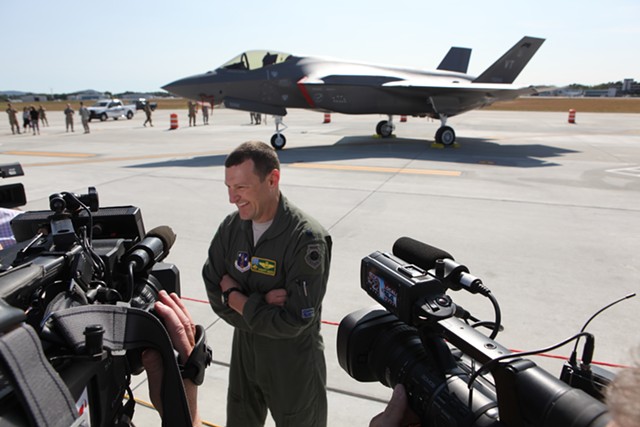
- Kevin McCallum
- Lt. Col. Tony Marek speaks to the media after flying one of the Air Guard's two new F-35s from Texas to Burlington.
For more than a decade, Chief Master Sgt. Dwight Rolston has been helping prepare the Vermont Air National Guard base and its members for the arrival of the F-35 Lightning II fighter jet.
Early Thursday afternoon, he was the first to confirm that the long wait was over.
“There they are!” Rolston called out across the bright tarmac crowded with media and guard officials.
He pointed south across the runway to a spot on the horizon between Camel's Hump and the control tower at Burlington International Airport.
First just two specks, the shapes grew steadily larger and more distinct as the angular profile of the most sophisticated, expensive and — for Vermont — controversial weapons system in the nation’s military arsenal came into view.
Cheers and whistles erupted from the crowd, but they were soon drowned out by the piercing roar of the powerful fighters. Lt. Col. Tony Marek and Lt. Col. Nathan Graber, the pilots, flew directly overhead and then banked right.
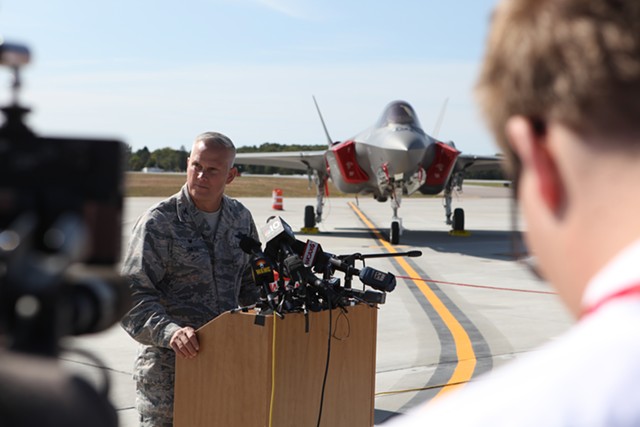
- Kevin McCallum
- Col. David Smith
After several low passes and sharp turns to demonstrate the agility of the $85 million aircraft, each headed over Winooski, turned left and landed at a base that welcomed them with relief and pride.
“What a proud and exciting moment this is for all of us,” Col. David Smith said after the planes taxied in and grounds crews covered components considered secret. “I just want to make sure it sinks in and remind everyone of something: You are all the first F-35 wing in the Air National Guard. The very first.”
Smith said the Vermont Air National Guard began working to get the F-35 based in Vermont 13 years ago, culminating in Thursday’s arrival. He said it had been a long and difficult effort, requiring sacrifice by members of the guard, active and retired, and their families.
The elected leader of the Vermont National Guard, Adjutant General Greg Knight, gave similar glowing remarks, praising his charges and their tireless work to prepare for the jet's arrival.
“You’ve earned this mission,” Knight said,.
The day began with the pilots picking up the aircraft at the Lockheed Martin manufacturing plant in Fort Worth, Texas. They took off around 10:30 a.m. and had an uneventful three-hour trip to Vermont, Marek explained.
The planes had only been flown a few times, so Marek said his “still had that new car smell.” The pair headed north, toward Indiana, at about 500 miles per hour, refueled in midair, and touched down in Vermont around 1:36 p.m., Marek said.
Another 18 F-35s will arrive at Burlington International Airport over the next 10 months. It’s not clear when they’ll take off again. For the first few weeks, anyway, the focus will be more on familiarizing the maintenance crews with the planes than flight training, Marek said.
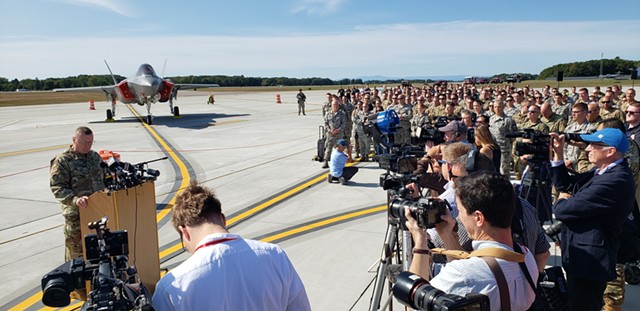
- Kevin McCallum
- Vermont National Guard Adjutant Gen. Greg Knight speaking to the crowd
When they do begin regular flights, Smith pledged during an interview last week, the use of afterburners will be limited to approximately 5 percent of takeoffs.
Critics have seized on higher afterburner usage at other bases as evidence that Burlington, which has a shorter runway than many other bases, would likely see higher afterburner usage here than the U.S. Air Force and the guard have predicted and studied.
But Smith explained that while the F-35 is heavier, it also has a far more powerful engine, which has no problem taking off in regular power, known as military power. The lighter F-16, when fully loaded, needed more than half of the 8,319-foot runway when taking off in military power, so safety regulations required the planes to use afterburners, he said.
In warm weather, the F-35 can take off in just 3,310 feet, Smith said.
“The engine generates far more thrust so you don’t need afterburner,” said Smith, a former F-16 pilot and commander of the Air Guard. “So, a military power take off, even with the additional gross weight, is very sufficient — plenty — to take off.”
Marek said on Thursday that he used afterburners whenever necessary while training at Edwards Air Force base in California, but that was because the jets were undergoing testing, not because they needed the additional thrust to take off, he said.
Afterburner or no, the jets are
expected to be louder for more people than were the F-16s. Recently released maps show that the number of dwelling units affected by high noise will nearly triple, to 2,640, by 2023. The number of people in the zone will rise to about 6,125.
Thursday's pomp and circumstance wasn't focused on all that. Allison Crowley, a lobbyist from Burlington whose father served in the Air National Guard and whose teenage son is training to be a Marine aviator, said it was an honor to witness the plane’s arrival and for the base to have been the first selected for such a mission.
“I think this is a proud day for the state of Vermont,” she said.









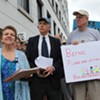
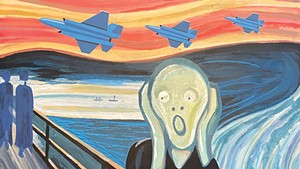
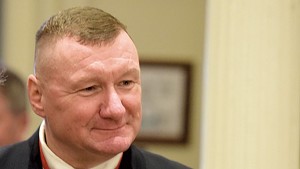
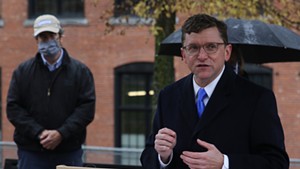

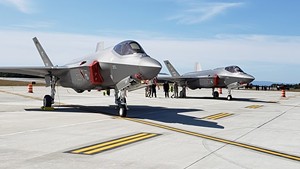




Comments (11)
Showing 1-11 of 11
Comments are closed.
From 2014-2020, Seven Days allowed readers to comment on all stories posted on our website. While we've appreciated the suggestions and insights, right now Seven Days is prioritizing our core mission — producing high-quality, responsible local journalism — over moderating online debates between readers.
To criticize, correct or praise our reporting, please send us a letter to the editor or send us a tip. We’ll check it out and report the results.
Online comments may return when we have better tech tools for managing them. Thanks for reading.